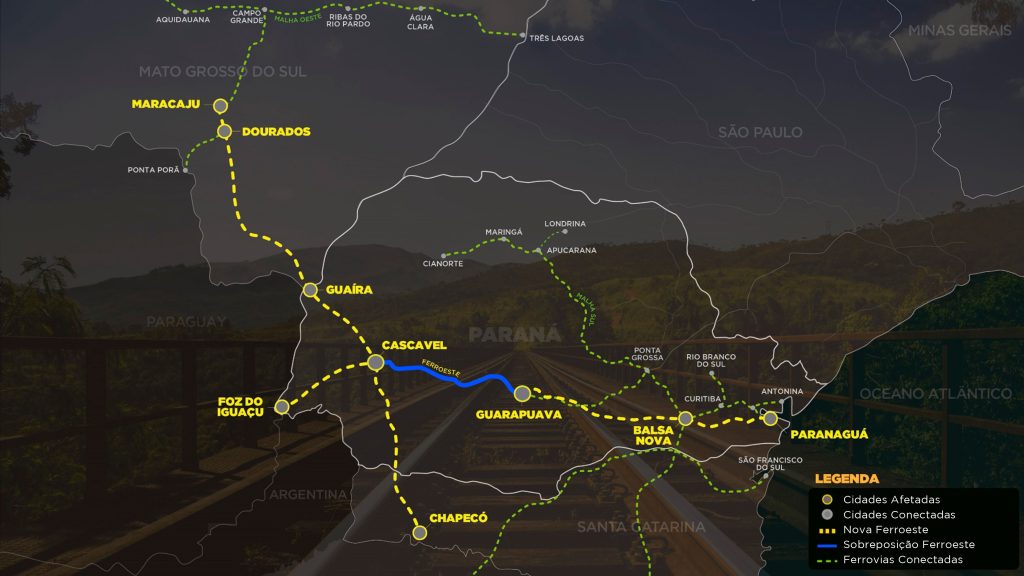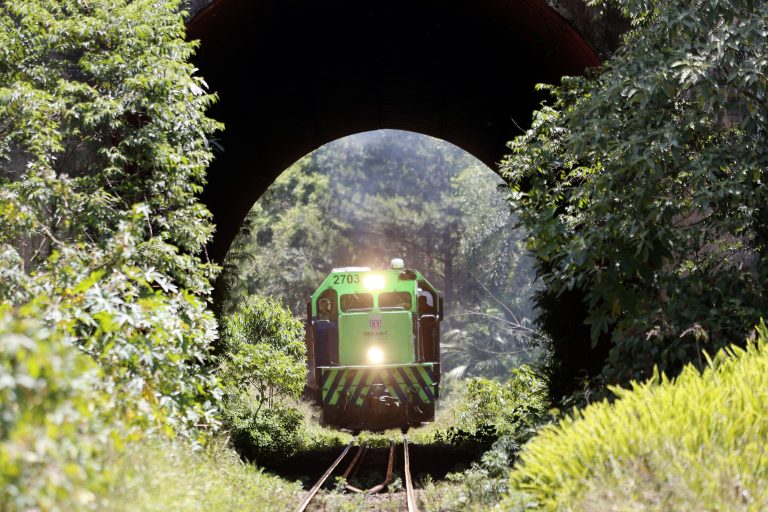São Paulo – The government of Paraná seeks investors to expand Nova Ferroeste, a project that will allow producers to send their crops from farms to the Port of Paranaguá – Brazil’s second largest port in tonnage and first in efficiency – and from there to the world. The railroad aims to connect three major agricultural regions in Brazil – Paraná, Mato Grosso do Sul, and Santa Catarina – which is expected to cut logistics costs by approximately 28% and allow the transit of goods for both domestic consumption and exports by means of a green project.
Some 1,567 kilometers (974 miles) of track are expected to be laid through 66 municipalities. The main line will connect Maracaju, Mato Grosso do Sul, to the port in coastal Paraná. Additional sidings are planned, too – one connecting Cascavel to Foz do Iguaçu to facilitate the transportation of cargo from Argentina and Paraguay, and another one connecting Cascavel to Chapecó, one of Brazil’s leading meat hubs.

“In most cities along the railway route, the path will circumvent major urban centers, steering clear from developing areas,” says Luis Henrique Fagundes, coordinator of the State Rail Plan.
“We pioneered this process of completely integrating the development of the project with its environmental impact assessment. We made sure it was compliant with the best environmental practices. As a result, we managed to avoid indigenous and quilombola lands as well conservation units by not crossing any of them. These included the Serra do Mar mountain range, a particularly tricky area. We chose a path that follows the course of the BR-277 highway that already exists, thus allowing us to work within its domain range and significantly reducing the environmental impact and its associated costs.”
According to Fagundes, the project has just what the world is seeking for now – it is green and strategically situated in a state to which gravitates, within a 1,000-km radius, 70% of South America’s gross domestic product. “We need the railroad to build on this strategic position of Paraná and become a logistics hub, that is, a strategic location from where companies can swiftly ship goods.” He pointed out that Paranaguá has been given the award of the most efficient port in Brazil for four years running. “I hope we gain this recognition a fifth time.”
“Nova Ferroeste is also appealing because it means food security. If we look to the Muslim community, for example, Paraná is Brazil’s largest exporter of halal chicken.” He explains that this production is extremely resilient and mentions the fight against covid-19 as an example. “The industry didn’t stop and kept exporting, as this was about food. We followed extremely strict sanitary procedures, and cooperatives had zero contamination in their plants.”
Train instead of truck
Nova Ferroeste will be environmentally friendly and have minimal environmental impacts. It actually represents a reduction in carbon emissions across the supply chain, from production to the final consumer. A single modern car called trem-tipo substitutes nearly four trucks on the roads. Using a train consisting of 140 of these cars means taking nearly 1,000 trucks out of the roads. This contributes not only to decarbonizing the supply chain but also significantly improves the delivery efficiency of goods like poultry. Furthermore, there is a large social benefit such as less trucks traveling over long distances. “Shipping companies now have 25% of their trucks out of service due to the lack of drivers,” he explained.

According to studies by the Food and Agriculture Organization (FAO), there will be a significant growth in food consumption over the next few years and some 50% of this demand will have to catered by Brazil. “Our country has the capacity to support this growth, since we can make two crops a year, like soybeans and then maize. We have a lot of land to expand the crop without damaging the environment.” Furthermore, the development of seeds, the water reuse, and new technologies for agriculture help to qualify Brazil as the world’s largest granary.
Fagundes mentions hundreds of acres of degraded grazeland as areas of potential agricultural growth. According to Fagundes, production could expand five times if these lands are resurrected. “This is possible because the world’s cattle breeding has changed. With six months of grazing and one year of confinement, cattle are already ready for slaughter.”
In dollars
Another important feature to be highlighted for foreign investors is the federal law 14286 from December 2021, also known as the Legal Framework for the Brazilian Exchange Market, which allows companies involved in the supply chain, transportation industry, and exports to have service contracts made in US dollar. “With part of the revenue in dollar, a natural hedging can be created for the enterprise. After all, if the dollar goes up, revenue goes up and makes up for the debt. If it goes down, so does the debt, and revenue will also cover it. There will be no need to hire any financial instrument for the exchange rate protection of the loan. This significantly lowers the cost of capital and makes investing in the Nova Ferroeste even more attractive,” says Fagundes.
When it is operational, the Nova Ferroeste will be Brazil’s second largest export corridor for containers and cereals, only behind the rail network of São Paulo that connects to the Port of Santos. “There is no other investment in infrastructure that I would deem more attractive in transport in Brazil, as it is a project for 99 years.”

Read more:
Egypt’s sheep, goat meat market opens up for Brazil
Report by Paula Medeiros, especially for ANBA.
Translated by Guilherme Miranda




